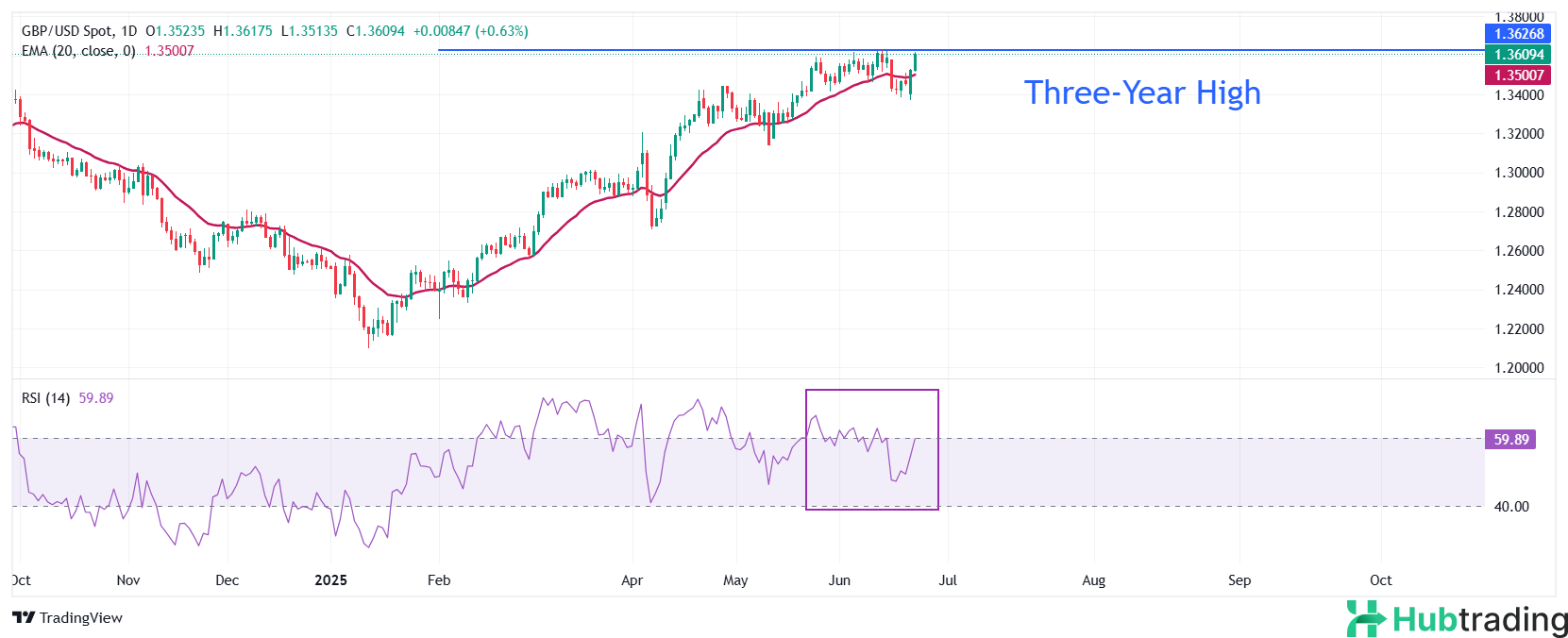-
The Pound Sterling climbs above 1.3600 against the US Dollar as easing tensions between Israel and Iran diminish safe-haven demand.
-
Stronger-than-expected UK flash PMI data for June provides additional support for the Pound.
-
Multiple Federal Reserve officials signal potential rate cuts in July to bolster the U.S. labor market.
The Pound Sterling (GBP) continues its upward momentum from Monday, rising toward 1.3620 against the US Dollar (USD) during European trading on Tuesday. The GBP/USD pair gains strength as a global risk-on mood—fueled by a ceasefire between Israel and Iran—reduces demand for safe-haven assets like the US Dollar.
The US Dollar Index (DXY), which measures the Greenback against a basket of six major currencies, drops sharply to around 98.13 on Tuesday, retreating from a two-week high near 99.40 set the day before.
In late Asian trading, Iranian state media confirmed the truce, stating that “a ceasefire came into effect between Iran and Israel following four waves of Iranian attacks on Israeli-occupied territories,” according to Reuters.
Later on Monday, U.S. President Donald Trump confirmed the agreement in a Truth.Social post, declaring that both Israel and Iran had agreed to a “Complete and Total CEASEFIRE.”
The de-escalation in the Middle East has triggered a sharp drop in oil prices—down nearly 15% from recent peaks—offering much-needed relief to oil-importing countries.
Pound Sterling Gains as BoE Flags Growth Concerns and Inflation Risks
- The Pound Sterling (GBP) extended its gains on Tuesday, outperforming most major currencies aside from those in the Asia-Pacific region. The uptick was driven by stronger-than-expected UK S&P Global Purchasing Managers’ Index (PMI) data for June and the Bank of England’s (BoE) continued commitment to a “gradual and calibrated” approach to monetary easing.
- Monday’s preliminary PMI report showed that UK business activity expanded more robustly than anticipated. Growth in the services sector remained steady, while manufacturing output contracted at a slower pace than forecast. Notably, new business volumes returned to growth after six consecutive months of decline. However, rising labor costs—linked to higher employer social security contributions—prompted firms to reduce staffing.
- Last week, the BoE kept its benchmark interest rate unchanged at 4.25%, reaffirming its cautious policy stance amid persistent risks. The central bank flagged potential pressures from energy prices and lingering vulnerabilities in the labor market.
- During Tuesday’s European session, BoE Monetary Policy Committee (MPC) member Megan Greene reinforced the central bank’s cautious tone, emphasizing that a “careful and gradual approach to removing monetary policy restrictiveness continues to be warranted.” Greene also warned of upside risks to inflation and downside risks to economic growth.
- Investors are now looking ahead to BoE Governor Andrew Bailey’s testimony before the Lords Economic Affairs Committee and a scheduled speech from Deputy Governor Dave Ramsden, both of which could provide further policy guidance.
- Across the Atlantic, U.S. flash PMI figures for June beat expectations. The Services PMI came in at 53.1 (versus 52.9 forecast), while Manufacturing PMI held at 52.0 (above the 51.0 projection). The report noted increased optimism among manufacturers, attributed to anticipated benefits from newly enacted trade policies under President Donald Trump.
- However, dovish commentary from Federal Reserve officials applied downward pressure on U.S. bond yields and the Dollar. On Tuesday, Fed Governor Michelle Bowman joined fellow Governor Christopher Waller in signaling a willingness to cut interest rates as early as July. Bowman said she would be “open to cutting rates as soon as the July FOMC meeting if inflation pressures stay contained,” citing early signs of labor market softness. Waller previously stated the Fed “should not wait for the job market to crash in order to cut rates.”
Technical Outlook: GBP/USD Eyes 3-Year High

The Pound Sterling climbed toward 1.3620 against the US Dollar on Tuesday, nearing its three-year high of 1.3630 set on June 13. The short-term trend for GBP/USD has turned bullish, with the pair trading above its 20-day Exponential Moving Average (EMA), currently around 1.3500.
The 14-day Relative Strength Index (RSI) has rebounded to near 60.00. A breakout above this level would signal fresh bullish momentum.
Key Support: 1.3250 (May 16 low)
Key Resistance: 1.3750 (January 13, 2022 high)
Correction: This story was updated at 08:42 GMT to clarify that the Pound's gains precede testimony from BoE Governor Andrew Bailey, not U.S. Federal Reserve Chair Jerome Powell.





